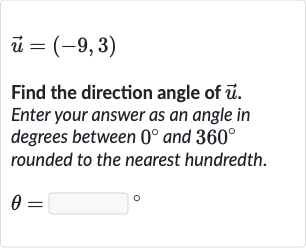Full solution
Q. Find the direction angle of . Enter your answer as an angle in degrees between and rounded to the nearest hundredth.
- Use Arctangent Function: To find the direction angle of the vector with components , we need to use the arctangent function, which gives us the angle whose tangent is the ratio of the y-component to the x-component of the vector. The formula for the direction angle is . However, since the vector is in the second quadrant (x is negative and y is positive), we need to add degrees to the angle we get from the arctangent function to get the correct direction angle.
- Calculate Arctangent: First, calculate the arctangent of the ratio of the y-component to the x-component of the vector . The y-component is and the x-component is . So, .
- Find Correct Angle: Using a calculator, we find that is approximately degrees. Since the arctangent function can return values between and degrees, and our vector is in the second quadrant, we need to add degrees to this value to find the correct direction angle.
- Add Degrees: Adding degrees to degrees gives us degrees. This is the direction angle of the vector in the range of to degrees.
More problems from Inverses of sin, cos, and tan: degrees
QuestionGet tutor help
QuestionGet tutor help
QuestionGet tutor help
QuestionGet tutor help
QuestionGet tutor help
QuestionGet tutor help
Question
. Find the value of in degrees.Write your answer in simplified, rationalized form. Do not round.____
Get tutor helpQuestionGet tutor help

